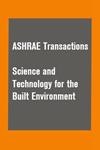New formulations and experimental validation of non-stationary convolutions for the fast simulation of time-variant flowrates in ground heat exchangers
IF 1.7
4区 工程技术
Q3 CONSTRUCTION & BUILDING TECHNOLOGY
Science and Technology for the Built Environment
Pub Date : 2023-11-06
DOI:10.1080/23744731.2023.2279468
引用次数: 0
Abstract
AbstractFlowrate control can have a significant positive impact on the thermal performance and economic profitability of ground-source heat pump systems. Including dynamic advective processes in the design phase, however, remains a challenging task, as few computationally efficient modeling tools allow for their adequate and accurate representation. The present work addresses this issue by presenting new formulations of non-stationary convolutions, an efficient simulation algorithm that relies on the theory of linear time-variant systems for predicting the thermal response of a ground heat exchanger to both dynamic heat loads and flow rates. First, the new original formulations are presented, which include 1) a simple time-domain expression and 2) a fast frequency-domain expression. Then, the efficiency and validity of the new formulations are verified using experimental multi-flowrate thermal response tests involving dynamic circulation, pumping and bleed flow rates in closed-loop and standing column well ground heat exchangers. Results show that the new formulations can reproduce the outlet fluid temperature of both experimental test cases with good accuracy ( MAE=0.06∘C and 0.26∘C, respectively). At last, the high efficiency of the new frequency-domain expression is demonstrated, with the computing times (0.04 s and 0.01 s) being 100 and 8 times faster than the original formulation in both scenarios.Keywords: Ground-source heat pump systemtime-variant flowratessimulation of ground heat exchangernon-stationary convolutionDisclaimerAs a service to authors and researchers we are providing this version of an accepted manuscript (AM). Copyediting, typesetting, and review of the resulting proofs will be undertaken on this manuscript before final publication of the Version of Record (VoR). During production and pre-press, errors may be discovered which could affect the content, and all legal disclaimers that apply to the journal relate to these versions also.非平稳卷积快速模拟地埋管时变流量的新公式及实验验证
摘要流量控制对地源热泵系统的热性能和经济效益有显著的积极影响。然而,在设计阶段包括动态平流过程仍然是一项具有挑战性的任务,因为很少有计算效率高的建模工具允许它们充分和准确地表示。目前的工作通过提出非平稳卷积的新公式来解决这个问题,非平稳卷积是一种有效的模拟算法,它依赖于线性时变系统理论来预测地面热交换器对动态热负荷和流量的热响应。首先,提出了新的原始公式,包括1)一个简单的时域表达式和2)一个快速的频域表达式。然后,通过多流量热响应实验验证了新公式的有效性和有效性,包括闭环和立柱井地热交换器的动态循环、泵送流量和排流量。结果表明,新配方能较好地再现两种试验用例的出口流体温度(MAE分别=0.06°C和0.26°C)。最后,证明了新频域表达式的高效率,在两种情况下,计算时间(0.04 s和0.01 s)分别比原公式快100倍和8倍。关键词:地源热泵系统时变流量地下热交换器模拟非平稳卷积免责声明作为对作者和研究人员的服务,我们提供此版本的已接受稿件(AM)。在最终出版版本记录(VoR)之前,将对该手稿进行编辑、排版和审查。在制作和印前,可能会发现可能影响内容的错误,所有适用于期刊的法律免责声明也与这些版本有关。
本文章由计算机程序翻译,如有差异,请以英文原文为准。
求助全文
约1分钟内获得全文
求助全文
来源期刊

Science and Technology for the Built Environment
THERMODYNAMICSCONSTRUCTION & BUILDING TECH-CONSTRUCTION & BUILDING TECHNOLOGY
CiteScore
4.30
自引率
5.30%
发文量
78
期刊介绍:
Science and Technology for the Built Environment (formerly HVAC&R Research) is ASHRAE’s archival research publication, offering comprehensive reporting of original research in science and technology related to the stationary and mobile built environment, including indoor environmental quality, thermodynamic and energy system dynamics, materials properties, refrigerants, renewable and traditional energy systems and related processes and concepts, integrated built environmental system design approaches and tools, simulation approaches and algorithms, building enclosure assemblies, and systems for minimizing and regulating space heating and cooling modes. The journal features review articles that critically assess existing literature and point out future research directions.
 求助内容:
求助内容: 应助结果提醒方式:
应助结果提醒方式:


